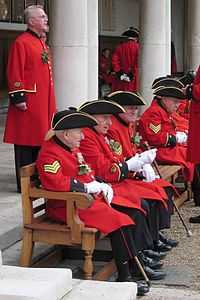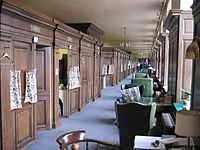Chelsea pensioner

A Chelsea pensioner is an in-pensioner at the Royal Hospital Chelsea, a retirement home and nursing home for former members of the British Army located in Chelsea, London. Historically, however, the phrase applied more widely, referring to both in-pensioners and out-pensioners.
In- and out-pensioners

During the reign of King William III and Queen Mary II, the Royal Hospital was still under construction, so they introduced a system for distribution of army pensions in 1689. The pension was to be made available to all former soldiers who had been injured in service, or who had served for more than 20 years.
By the time the Hospital was completed, there were more pensioners than places available in the Hospital. Eligible ex-soldiers who could not be housed in the Hospital were termed out-pensioners, receiving their pension from the Royal Hospital but living outside it. In-pensioners, by contrast, surrender their army pension and live within the Royal Hospital.
In 1703, there were only 51 out-pensioners. By 1815 this figure had risen to 36,757.
The Royal Hospital remained responsible for distributing army pensions until 1955, following which the phrase "out-pensioner" became less common, and "Chelsea pensioner" was used largely to refer to "in-pensioners".
Life of in-pensioners

Upon arrival at the Royal Hospital, each in-pensioner is given a "berth" in a ward, a small room (9 feet x 9 feet) on a long corridor, and is allocated to a company. In-pensioners surrender their army pension, in return receiving board, lodging, clothing and full medical care.
The size of the hospital berths has increased over time. There are 18 berths to a ward.
Conditions for admission as an in-pensioner
To be eligible for admission as a Chelsea Pensioner, a candidate must be a former warrant officer, non-commissioned officer, or soldier of the British Army (including National Service) who is:
- Over 65 years of age, and;
- Either in receipt of an Army Service Pension or War Disability Pension which they are required to surrender upon entry to the Royal Hospital or, if they do not receive an Army Pension they are required to pay a £175 per week (as at 2013) contribution towards their living costs, and;
- Free of any financial obligation to support a spouse or family, and;
- Be self-caring and able to live independently on the Long Wards.
Also eligible for admission are former commissioned officers of the British Army who meet the criteria, provided they served for at least twelve years in the ranks before obtaining a commission or if they were awarded a disablement pension while serving in the ranks.
Admission of women
Until 2009, only male candidates were admitted. It was announced in 2007 that female ex-service personnel would be admitted on the completion of modernisation of the long wards.[1] In March 2009 the first women in the Hospital’s 317 year history were admitted as In-Pensioners. Dorothy Hughes (aged 85) was the first, soon followed by Winifred Phillips (aged 82).
Hughes had joined the British Army in 1941, later working as part of 450 Heavy Anti Aircraft Battery in the London Division. In 1945 the Battery was deployed near Dover to defend against V1 rocket attacks. Phillips trained as a nurse and later joined the Auxiliary Territorial Service in 1948 before enlisting in the Women's Royal Army Corps in 1949 while serving in Egypt. After 22 years service she retired with the rank of Warrant Officer Class 2.[2][3][4][5][6]
However, the records at Chelsea Hospital do show that another woman, a Mrs. Christian Davies, was admitted to Chelsea Hospital circa 1717, and was awarded a pension for her service in the army and the wounds she received in the service of the King. She died in 1739 and was buried in the Royal Hospital Chelsea with full military honours.
Clothing

In-pensioners are entitled to come and go from the Royal Hospital as they please, and are permitted to wear civilian clothing wherever they travel. However, within the Hospital, and in the surrounding area, in-pensioners are encouraged to wear a blue uniform. If they travel farther from the Hospital, they should wear the distinctive scarlet coats instead of the blue uniform. The scarlet coats are also worn for ceremonial occasions, accompanied by tricorne hats. (At other times a peaked hat, known as a shako, is generally worn).
In uniform, the pensioners wear their medal ribbons and the insignia of the rank they reached while serving in the armed forces. They may also wear other insignia they earned during their service and many pensioners now wear parachute jump wings and even SAS jump wings. Contrary to popular belief, it is not illegal to impersonate a Chelsea Pensioner; the myth probably dates from a ruling prohibiting fraudulent claims to pensions that belonged to Chelsea Pensioners. (repealed by the Statute Law (Repeals) Act 2008).
Men In Scarlet album
Seven Chelsea Pensioners at the Royal Hospital Chelsea released an album on 8 November 2010 in order to raise money for the Chelsea Pensioners' Appeal. Featuring Dame Vera Lynn, Katherine Jenkins, The Soldiers, and Janey Cutler, the album is full of well known wartime songs and includes their traditional march, "The Old Brigade".[7] The Chelsea Pensioners' Appeal is currently trying to raise £30 million for the refurbishment of the Chelsea Pensioners' living accommodation.[8] On 13 December on The Alan Titchmarsh Show, it was announced that the album had sold 100,000 copies.
Chelsea Football Club
Nearby Chelsea Football Club has been affiliated with the Chelsea Pensioners for many years; the club's first nickname was the Pensioners and until the 1950s the club crest featured a Chelsea pensioner. Residents of the Hospital can still be seen attending Chelsea's home games at Stamford Bridge.[9] When Chelsea won the Premier League title in 2005, Chelsea pensioners formed a guard of honour as the players and management came out for the trophy presentation; this was done again when Chelsea won the title in 2010.[10] In tribute to the trademark red coats worn by the pensioners, Chelsea's kit for the 2010-11 season featured a red trim on the collars.[11]
References
- ↑ Women to join Chelsea pensioners BBC News 26 February 2007
- ↑ ‘The ladies in red: Chelsea Pensioners welcome first female recruits in 300>-year history’ Daily Mail 13 March 2009
- ↑ ‘Dorothy Hughes and Winifred Phillips become first female Chelsea Pensioners’ The Times’’ 13 March 2009
- ↑ "First Women in Scarlets". News of the Royal Hospital Chelsea. Archived from the original on 23 August 2009. Retrieved 1 June 2014.
- ↑ 'Now I feel just like Cinderella at the ball' Daily Telegraph’’ 5 March 2009
- ↑ "Women joining Chelsea pensioners, BBC News, 12 March 2009
- ↑ "The Royal Hospital Chelsea - Men In Scarlet". Retrieved 11 October 2010.
- ↑ "The Royal Hospital Chelsea - Appeal". Archived from the original on 8 September 2013. Retrieved 11 October 2010.
- ↑ "Pensioners take a closer look". Chelseafc.com. 6 May 2010. Retrieved 1 June 2014.
- ↑ "Makelele kicks off celebrations". Daily Telegraph. 8 May 2005. Retrieved 22 February 2011.
- ↑ "Chelsea's Blues will be in the red next season". London Evening Standard. 14 April 2010. Retrieved 19 February 2011.